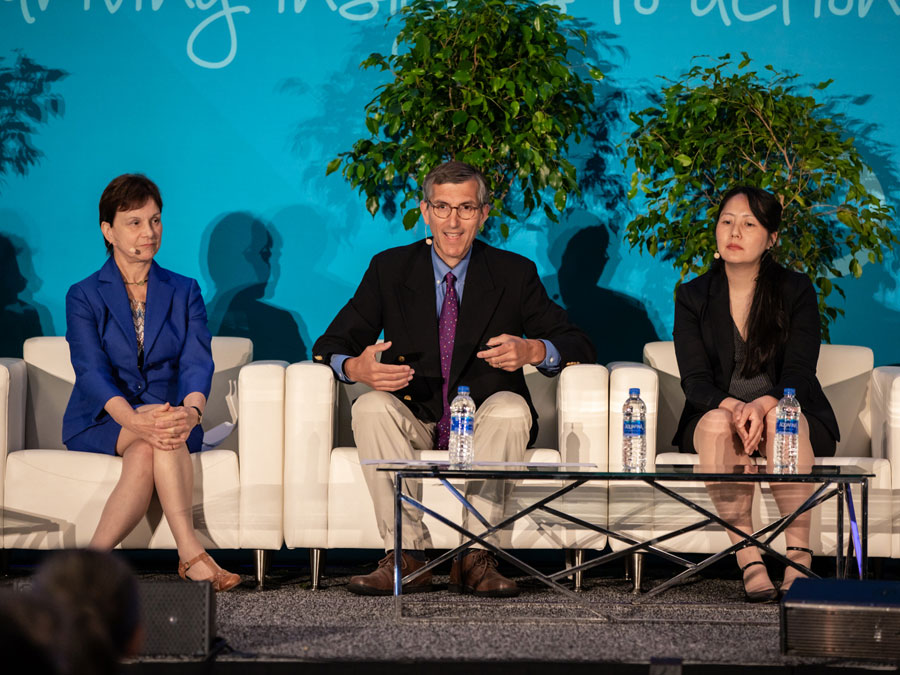Proceedings: DIA 2018 Global Annual Meeting

FDA Town Hall
Chris M. Slawecki
DIA Senior Digital Copy Editor
ndustry professionals work under the guidance and jurisdiction of the US FDA’s Centers for Evaluation & Research for Drugs (CDER) and for Biologics (CBER) every day of the year. But on one special day, DIA Annual Meeting attendees get to hear directly from these Centers’ executive leadership, and pose their own questions to them. This year’s “FDA Town Hall,” the traditional DIA Global Annual Meeting closing DIAmond session, was particularly lively and engaging. After each panelist made their own summary presentation, they engaged in a dynamic and at times humorous question and answer session with the audience.
CDER Summary Presentation
Opioid Abuse Epidemic
- This fight is a multi-agency, multi-state, and federal effort.
- More than 100,000 people have entered a new FDA training program for opioid risk evaluation mitigation strategies.
- Online sellers and international mail facilities are receiving more scrutiny from FDA.
- Prescription and package sizes will also be more closely examined. (“If someone has a minor injury, they shouldn’t get sixty pills.”)
FDA Commissioner’s Drug Competition Action Plan (DCAP)
- Unveiled in May 2017, the FDA Commissioner’s Drug Competition Action Plan (DCAP) ensures that FDA maximizes incentivizing new drug innovation and facilitating generic drug access as Congress intended.
- DCAP deliverables were developed based on program needs identified by Subject Matter Experts in CDER’s Office of Generic Drugs, CDER’s Office of Pharmaceutical Quality, CDER’s Office of Regulatory Policy, and Office of Chief Counsel.
- DCAP deliverables also align with the provisions of the Generic Drug User Fee Act (GDUFA) II.
- DCAP reduces opportunities for “gaming” that allow brand companies to withhold originator product from generic manufacturers, which extends the innovator’s monopoly beyond its legal limits and delays approvals of less costly generics.
- DCAP will also enhance development and review of complex product Abbreviated New Drug Applications to increase approval output.
New Drugs Regulatory Program Modernization
Woodcock reviewed the CDER process modernization program that she first discussed on the FDA Voice blog, FDA Proposes Process Modernization to Support New Drug Development. CDER currently has 19 separate review divisions that regulate drugs; many of these divisions have developed, over time, procedures specific to their own areas of review. This proposal would centralize all these project management functions into one organization with one single, consistent process. It will allow CDER scientific and clinical experts to focus on what they know best (science and medicine) and free up regulatory experts to manage regulatory processes. “While everyone focuses on the reorganization, this is primarily about process change,” Woodcock said.

Janet Woodcock (left) and Tamy Kim (right) listen to Peter Marks during the FDA Town Hall.
CDER Challenges
“Science doesn’t give you the answers. It gives you the facts,” Woodcock explained. But CDER executes science within specific legal, legislative, and policy frameworks, and such frameworks are based on and reflect principles that may not be unanimously accepted across the healthcare system. Who determines how much of what risk is acceptable to whom, and how? “Our stakeholders have different opinions about uncertainty,” she said.
CBER Summary Presentation
CBER reviews “more complex biological products” such as blood products, human tissue products, cellular products, preventative and therapeutic vaccines, transplantation products, and devices related to these products. Novel products in development or recently approved through CBER include chimeric antigen receptor-T (CAR-T) cells (two approvals within the past year) and bioengineered skin, blood vessels, and bladders. Some of these were not even envisioned just a decade ago.
Regenerative Medicine Advanced Therapy (RMAT) Designation
- The Regenerative Medicine Advanced Therapy Designation was established by the 21st Century Cures Act to expedite the development and review of advanced regenerative therapies: a cell therapy, therapeutic tissue engineering product, human cell and tissue product, or any combination product using such therapies or products.
- “Somewhat analogous to the Breakthrough Therapy Designation” (BTD) with two important distinctions:
- Preliminary clinical evidence must indicate potential to address unmet medical need (it must deliver a clear therapeutic benefit for BTD).
- RMAT products have an expanded range of options for fulfilling post-approval requirements.
- CBER has granted RMAT designation to 24 products, mostly cellular therapy or cell-based gene therapy products, out of 66 requests; this designation rate compares favorably to CBER’s BTD designation rate (39 designations granted out of 122 requests as of the end of 2017).
- CBER welcomes novel endpoints and clinical study designs to advance development of these therapies.
Gene Therapy Products
Even though production processes and associated costs for gene therapy products remain orders of magnitude beyond what industry can sustain, the Agency is simplifying interactions to streamline review and approval of these products.
- Gene therapy protocol sponsors interact with the Recombinant DNA Advisory Committee (RAC) at both the FDA and NIH for review, approval, and adverse event reporting.
- FDA and NIH are collaborating on a new proposal to reduce the regulatory burden imposed by this RAC, while enhancing the value it adds.
Marks also introduced attendees to the Center’s new INTERACT Program: Initial Targeted Engagement for Regulatory Advice on CBER ProducTs designed to systemize more informal “pre-pre-IND meetings” with smaller developers.
CBER Challenges
Two related challenges: Keeping up with the FDA human resource requirements of professionals familiar with these technologies; while maintaining that critical balance between delivering safe and effective products, and delivering these products more quickly. We still have so many unknowns, both known and unknown, Marks suggested, and this is true all around the world, not just in the US.
Oncology Center of Excellence (OCE) Summary Presentation
- Established in January 2017 as part of the 21st Century Cures Act to leverage the combined skills of regulatory scientists and reviewers with expertise in drugs, biologics, and devices (including diagnostics) in the review and approval of products and therapies to fight cancer.
- The OCE has a Director, Deputy Director, and a number of Associate Directors respectively for cell and gene therapies, medical devices, in vitro diagnostics, pediatrics, regulatory science and informatics, patient outcomes, immuno-oncology, Regulatory Affairs, and Research Strategy and Partnerships.
- First-year (2017) accomplishments include:
- First patient advocacy workshop.
- Clinical review for 12 new drugs and biologics, plus two biosimilars, for treatment of cancer.
- Clinical review of one new medical device to diagnose a patient for cancer treatment.
- Implemented “OCE Clinical Rounds,” cross-center forums that bring together reviewers across all three Centers with sponsors, who provide updates on specific applications as well as items coming soon from their pipelines.
Session Chair: Sudip Parikh, Senior Vice President & Managing Director, DIA Americas
Panelists: Janet Woodcock, Director, Center for Drug Evaluation & Review (CDER); Peter Marks, Director, Center for Biologics Evaluation & Research (CBER); Tamy Kim, Acting Associate Director for Regulatory Affairs, Oncology Center of Excellence (OCE)
Audience questions answered by the panelists included: Why are your informatics systems so archaic?
For example, reviewers from different Centers cannot access each other’s databases. “We want to modernize and we’ll do our best,” Marks allowed, with a hint of tongue-in-cheek humor. Woodcock pointed out that outsourcing IT and informatics systems might be a good solution because private industry has already solved a lot of the informatics problems with which the Agency is still struggling.
How do you feel about “Right to Try” legislation?
This law creates an exemption from certain criteria which restrict the distribution of certain products. By definition, this law removes FDA from this distribution process – it’s now between the patient and the company, Woodcock explained. “Our place is to do what we’re tasked to do in this process, which is almost nothing”, Marks concurred. FDA is directed by this Act to not get involved.
What can the stakeholder community give to FDA?
Tell us what you need because a lot of times we don’t know until you tell us, Kim suggested. Participate in public workshops and in other forums that allow us to hear from you.
Rushing through a clinical development plan only to discover that you can’t sustain product manufacturing does no one any good, said Marks. Define and operationalize manufacturing quality as soon as you begin.

